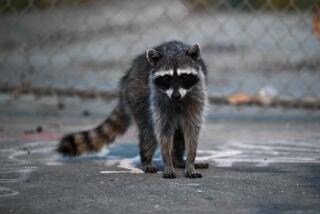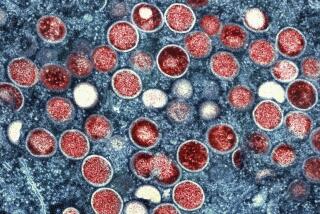Tulane worker may have been exposed to bacteria on bioweapons list
A veterinary clinic worker at Tulane University might have been exposed to bacteria that can be used for bioterrorism and that a nearby research laboratory failed to contain, a federal official confirmed Wednesday night.
An initial test showed that the worker at the Tulane National Primate Research Center in Louisiana had antibodies to Burkholderia pseudomallei, said Jason McDonald, a spokesman for the national Centers for Disease Control and Prevention.
But the worker is not ill, McDonald said, and the presence of antibodies just means the immune system has built up a defense against the bacteria. Furthermore, the test result may be a false positive, he said, and even if antibodies are confirmed, the worker’s exposure to the bacteria might have occurred long ago and elsewhere.
Nor is there any evidence that the public is in danger. “There’s nothing to indicate to us that the general public is at any significant risk,” McDonald cautioned.
Regardless of whether this worker was exposed, the bacteria did get out of a lab at the primate research center, the CDC said.
Late last year, the CDC said in a statement, two primates fell ill with melioidosis caused by the same strain of B. pseudomallei that the lab was using for research. Those two rhesus macaques were never used in research and lived at a breeding facility more than half a mile from the lab, McDonald said. Six other macaques at the facility have tested positive for antibodies to the bacteria, though they did not fall ill, he said.
Last month, the lab was ordered to stop working with “select agents,” as microbes on the government’s list of potential bioweapons are called, until a federal investigation is complete.
Melioidosis has a wide variety of symptoms that can be mistaken for pneumonia. The disease, more commonly found in tropical areas, is widespread in Southeast Asia and northern Australia, according to the CDC.
B. pseudomallei is mainly spread through contact with contaminated water and soil, and it is very rare for one person to transmit it to another, the CDC says.
The bacterium in its current form is not particularly potent, McDonald said. He said it is on the list of select agents “because of its ability to be manipulated by man and made more lethal or dangerous.”
This is not the first case in which pathogens have turned up in places they were not supposed to be.
Last July, National Institutes of Health workers in Bethesda, Md., were surprised to find six long-lost vials of smallpox in a disused storage room.
In December, material that may have contained live Ebola virus was mistakenly moved from one lab to another at a CDC facility in Atlanta.
For more news, follow @raablauren on Twitter.
More to Read
Sign up for Essential California
The most important California stories and recommendations in your inbox every morning.
You may occasionally receive promotional content from the Los Angeles Times.










